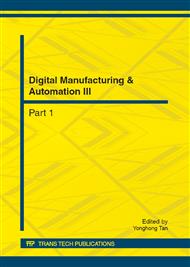[1]
B. Selvan, et al., Numerical modelling of ar-n2 plasma jet impinging on a flat substrate, Journal of Thermal Spray Technology, 2011, pp.534-548.
DOI: 10.1007/s11666-010-9587-8
Google Scholar
[2]
B. Liu, et al., Computational analysis of the influence of process parameters on the flow field of a plasma jet, Surface and Coatings Technology, (2000).
Google Scholar
[3]
F. Qunbo, et al., 3d simulation of the plasma jet in thermal plasma spraying, Journal of Materials Processing Technology, 2005, p.224–229.
DOI: 10.1016/j.jmatprotec.2004.08.022
Google Scholar
[4]
G. Mariaux, A. Vardelle, 3-d time-dependent modelling of the plasma spray process. Part 1: Flow modelling, International Journal of Thermal Sciences, 2005, pp.357-366.
DOI: 10.1016/j.ijthermalsci.2004.07.006
Google Scholar
[5]
I. Ahmed, T.L. Bergman, Simulation of thermal plasma spraying of partially molten ceramics: Effect of carrier gas on particle deposition and phase change phenomena, Transactions of the ASME, (2000).
DOI: 10.1115/imece2000-1499
Google Scholar
[6]
Y. Bai, et al., Structure–property differences between supersonic and conventional atmospheric plasma sprayed zirconia thermal barrier coatings, Surface and Coatings Technology, 2011, pp.3833-3839.
DOI: 10.1016/j.surfcoat.2011.01.056
Google Scholar
[7]
Y. Bai, et al., High performance nanostructured zro2 based thermal barrier coatings deposited by high efficiency supersonic plasma spraying, Applied Surface Science, 2011, pp.7210-7216.
DOI: 10.1016/j.apsusc.2011.03.092
Google Scholar
[8]
Y. Bai, et al., Microstructural study of nanostructured zro2 based thermal barrier coatings fabricated by high efficiency supersonic plasma spraying, Advanced Materials Research, 2011, pp.80-87.
DOI: 10.4028/www.scientific.net/amr.189-193.80
Google Scholar
[9]
V. Rat, et al., Two-temperature transport coefficients in argon–hydrogen plasmas—i: Elastic processes and collision integrals, Plasma Chemistry and Plasma Processing, 2002, pp.453-474.
Google Scholar
[10]
P. Andre´, et al., A new modified pseudoequilibrium calculation to determine the composition of hydrogen and nitrogen plasmas at atmospheric pressure, Plasma Chemistry and Plasma Processing, 2000, pp.83-105.
Google Scholar
[11]
J. Trelles, et al., Arc plasma torch modeling, Journal of Thermal Spray Technology, 2009, pp.728-752.
Google Scholar
[12]
B. Selvan, et al., Numerical and experimental studies on dc plasma spray torch, Vacuum, 2009, pp.444-452.
DOI: 10.1016/j.vacuum.2009.09.009
Google Scholar
[13]
B. Selvan, K. Ramachandran, Comparisons between two different three-dimensional arc plasma torch simulations, Journal of Thermal Spray Technology, 2009, pp.846-857.
DOI: 10.1007/s11666-009-9343-0
Google Scholar


